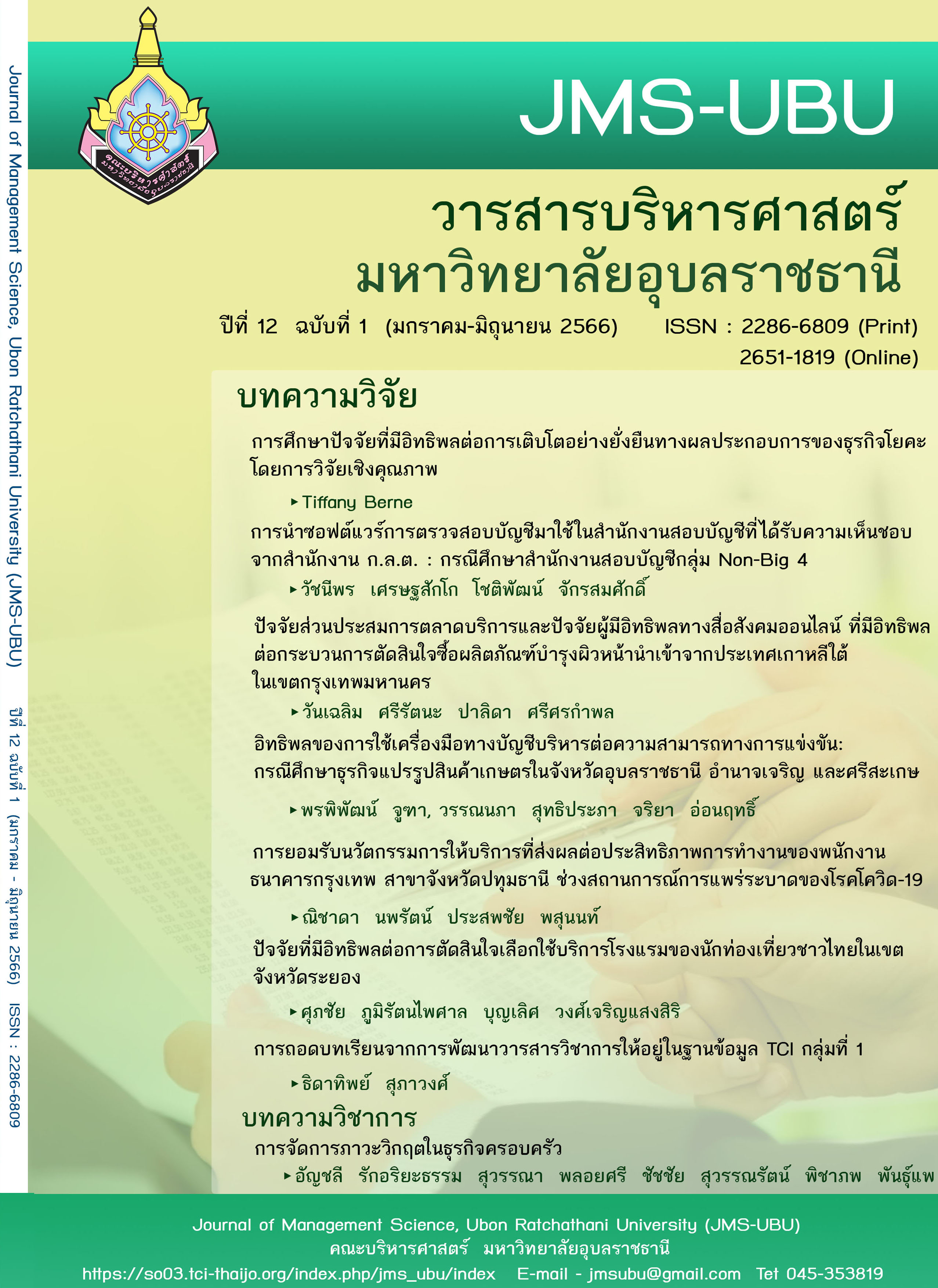อิทธิพลของการใช้เครื่องมือทางบัญชีบริหารต่อความสามารถทางการแข่งขัน: กรณีศึกษาธุรกิจแปรรูปสินค้าเกษตรในจังหวัดอุบลราชธานี อำนาจเจริญ และศรีสะเกษ
Main Article Content
บทคัดย่อ
การวิจัยนี้มีวัตถุประสงค์เพื่อศึกษาเครื่องมือทางบัญชีบริหารที่นำมาใช้ในการบริหารต้นทุนการผลิตทั้งแบบดั้งเดิมและแบบสมัยใหม่ และศึกษาอิทธิพลของการใช้เครื่องมือดังกล่าวที่มีต่อความสามารถทางการแข่งขันของธุรกิจแปรรูปสินค้าเกษตร มีกลุ่มตัวอย่างคือธุรกิจแปรรูปสินค้าเกษตรที่ตั้งอยู่ในจังหวัดอุบลราชธานี อำนาจเจริญ และ ศรีสะเกษ รวมจำนวน 48 แห่ง โดยใช้แบบสอบถามเป็นเครื่องมือในการวิจัย และวิเคราะห์ข้อมูลด้วยค่าร้อยละ ค่าเฉลี่ย ส่วนเบี่ยงเบนมาตรฐาน การวิเคราะห์ปัจจัย และการวิเคราะห์ความถดถอยเชิงพหุ ผลการวิจัยพบว่า แนวคิดการบริหารต้นทุนแบบดั้งเดิมที่ธุรกิจแปรรูปสินค้าเกษตรส่วนใหญ่นำมาใช้คือ การจัดหาวัตถุดิบที่มีคุณภาพ และการมีบุคลากรที่พอเพียง สำหรับแนวคิดการบริหารต้นทุนแบบสมัยใหม่ ส่วนใหญ่มีการนำระบบการผลิตแบบลีนมาใช้ นั่นคือ การตรวจสอบคุณภาพการผลิตอย่างสม่ำเสมอและเน้นการผลิตตามความคำสั่งชื้อของลูกค้า แต่มีการนำระบบต้นทุนฐานกิจกรรมเข้ามาใช้ค่อนข้างน้อย โดยเฉพาะการวิเคราะห์กิจกรรมที่เพิ่มมูลค่าและกิจกรรมที่ไม่เพิ่มมูลค่าในการผลิต นอกจากนี้ ยังพบว่า การใช้เครื่องมือทางบัญชีบริหารในการบริหารต้นทุนการผลิตนั้นมีอิทธิพลต่อความสามารถทางการแข่งขัน นั่นคือ การตรวจสอบคุณภาพและประสิทธิภาพในการผลิตของบุคลากรมีอิทธิพลเชิงบวกต่อความสามารถทางการแข่งขันทั้ง 3 ด้าน คือ ดัชนีความมั่นคงทางการเงิน ดัชนีความสามารถในการทำธุรกิจ และดัชนีความยั่งยืนของธุรกิจ
Downloads
Article Details

อนุญาตภายใต้เงื่อนไข Creative Commons Attribution-NonCommercial-NoDerivatives 4.0 International License.
บทความที่ตีพิมพ์ในวารสารบริหารศาสตร์ มหาวิทยาลัยอุบลราชธานี เป็นลิขสิทธิ์ของวารสาร โดยเนื้อหาและความคิดเห็นในบทความเป็นความรับผิดชอบของผู้เขียนแต่ละท่าน ไม่เกี่ยวข้องกับคณะบริหารศาสตร์ มหาวิทยาลัยอุบลราชธานีแต่อย่างใด และหากมีข้อผิดพลาดประการใด ผู้เขียนจะเป็นผู้รับผิดชอบต่อบทความของตนเองแต่เพียงผู้เดียว
เอกสารอ้างอิง
กรมโรงงานอุตสาหกรรม, (2560). สถิติสะสมจำนวนโรงงานที่ได้รับอนุญาตให้ประกอบกิจการ ตาม พ.ร.บ.โรงงานพ.ศ. 2535 จำแนกตามจังหวัด รายจำพวก ณ สิ้นปี 2560. สืบค้นเมื่อ 10 พฤษภาคม 2561, จาก www.diw.go.th
ดนุชา คุณพนิชกิจ, (2555). การผลิตแบบลีน: ผลกระทบต่อการบัญชี. จุฬาลงกรณ์ธุรกิจปริทัศน์, 34(132), 1-9.
บุญชม ศรีสะอาด, (2535). หลักการวิจัยเบื้องต้น (พิมพ์ครั้งที่ 3). กรุงเทพฯ: สุวีรยาสาสน์.
มนวิกา ผดุงสิทธิ์, (2562). การบัญชีต้นทุน Cost Accounting (พิมพ์ครั้งที่ 9). กรุงเทพมหานคร: ฟิสิกส์เซ็นเตอร์.
ศูนย์พยากรณ์เศรษฐกิจและธุรกิจ มหาวิทยาลัยหอการค้าไทย, (2559). ดัชนีความสามารถในการแข่งขันของธุรกิจ SMEs. สืบค้นเมื่อ 1 ธันวาคม 2559, จาก http://cebf.utcc.ac.th
สำนักงานเศรษฐกิจการเกษตร, (2560). สถิติการเกษตรของประเทศไทย ปี 2559. สืบค้นเมื่อ 30 มิถุนายน 2560, จาก http://www.oae.go.th/assets/portals/1/files/ebook/yearbook59.pdf
สุดใจ ผ่องแผ้ว และ นุจรี ภาคาสัตย์, (2559). รูปแบบความสามารถทางการแข่งขันของผู้ประกอบการ OTOP ที่เป็นSMEs ในประเทศไทย. Veridian E-Journal, Silpakorn University ฉบับภาษาไทย สาขามนุษยศาสตร์ สังคมศาสตร์ และศิลปะ, 9(3), 1659-1675.
สุวรรณ หวังเจริญเดช, (2561). Determinants on creativity of modern cost management and corporate sustainability: An empirical evidence from furniture exporting business in Thailand. วารสารวิชาการมหาวิทยาลัยฟาร์อีสเทอร์น, 12(2), 263-276.
Aaker, D. A., Kumar, V. & Day, G. S. (2001). Marketing Research (7th ed.). New York: John Wilery &Sons.
Botin, J. A., & Vergara, M. A. (2015). A cost management model for economic sustainability and continuous improvement of mining operation. Resources Policy, 46, 212-218.
Davol, N. B., Mayor, M. G., & de la Hera, M. L. B. (2011). Empirical analysis of technological innovation capacity and competitiveness in EU-15 countries. African Journal of Business Management, 5(14), 5,753-5,765.
Dubovaya, V., Komelina, A., & Ismail, S. H. (2018). The strategic framework of cost management for production competitiveness: World experience. International Journal of Engineering & Technology, 7(4.3), 432-437.
Ellram, L. M., & Stanley, L. L. (2008). Integrating strategic cost management with a 3DCE environment: Strategies, practices, and benefits. Journal of Purchasing & Supply Management, 14(3), 180-191.
Hagiu, A. (2012). Cost management-essential factor for increasing the competitiveness of the Romanian sugar industry. In Sustainable Rural Development. International Scientific Symposium. Timișoara, Romania.
Hilton, R. W., Maher, M. W., & Selto, F. H. (2008). Cost Management: Strategies for Business Decisions (4th ed.). McGraw-Hill: IRWAN.
Jaf, R. A. S., Sabr, S. A., & Nader, K. A. (2015). Impact of management accounting techniques on achieve competitive advantage. Research Journal of Finance and Accounting, 6(4), 84-98.
Kongkiti Phusavat, & Rapee Kanchana. (2007). Competitive priorities of manufacturing firm in Thailand. Industrial management and Data Systems, 107(7), 979-996.
Kornchai Phornlaphatrachakorn. (2018). Strategic cost management and firm profitability: An empirical investigation of instant foods and convenience foods business in Thailand. International Journal of Business, 23(4), 358-371.
Krumwiede, K. R., & Charles, S. L. (2014). The use of activity-based costing with competitive strategies: Impact on firm performance. Advances in Management Accounting, 23, 113-148. Bingley: Emerald Group Publishing Limited.
Liu, Q. (2015). Research on strategic cost management in modern enterprises. Management and Engineering, 21, 32-35.
Malik, Q. A. Saif, M. I., Safwan, N. & Gulzar, A. (2011). Impact of organizational innovation on success of cost management techniques in value creation: Evidence from manufacturing sector of Pakistan. Africa Journal of Business Management, 5(15), 6,618-6,624.
Melo, M. A., & Leone, R. J. G. (2015). Alignment between competitive strategies and cost management: A study of small manufacturing companies. Brazilian Business Review, 12(5), 78-96.
Rounaghi, M. M., Jarrar, H., & Dana, L. P. (2021). Implementation of strategic cost management in manufacturing companies: Overcoming costs stickiness and increasing corporate sustainability. Future Business Journal. DOI: 10.1186/s43093-021-00079-4
Ruan, S. (2020). Research on strategic cost management of enterprise based on Porter’s value chain model, Journal of Physics: Conference Series. DOI:10.1088/1742-6596/1533/2/022056
Shi, H. Y. (2005). Activity based costing and value chain analysis applied in cost management system. (Doctoral Dissertation). South China University of Technology.
Sulaeva, S., & Gultceva, O. B. (2016). Traditional and modern cost management systems: A scope and distinctive features. π-Economy, 4(246), 173-180.

